Full Cycle
- At March 05, 2021
- By admin
- In Annes Letters
 0
0
Dear Family and Friends,
It has been several months since I started physical therapy for my arm. The Japanese take a gentle approach, which means extended time for rehabilitation. I like my therapist a lot and the hospital is very pleasant. However, I am finding this long, ongoing process has become rather tedious.
Today, though, as I approached the entrance to the hospital, I was greeted by something very unusual. Nurses were wheeling an ancient man in a bed outside. He was so old and frail that he seemed to be teetering on the edge between this life and the next. Despite his fragility, however, he was alert.
There, eagerly waiting for him was a lovely young mother, holding her newborn. “Grandfather, Grandfather, I want to introduce you to my baby,” she said, as she held her swaddled infant up for this great-great grandfather to see.
The old man slowly lifted his stick-like arms and touched the cheeks of the wide-eyed baby. “Ah, ah,” he kept repeating. Love and joy radiated everywhere around them. It was obvious the new mother loved her (great) grandfather very much, and he her. And now there was a new generation of the family to love.
I was deeply stuck not only by the warmth of the scene, but also how it so poignantly and neatly expressed the entire cycle of life. I have had a lot of “big” questions as I work with my arm and wait for it to heal. Yet, somehow what I witnessed today explained everything. It also gave me the courage to continue my efforts to transform my thinking as I enter the early stages of my own aging.
Love,
Anne
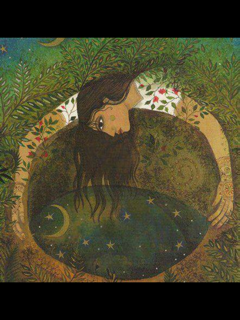
It has been several months since I started physical therapy for my arm. The Japanese take a gentle approach, which means extended time for rehabilitation. I like my therapist a lot and the hospital is very pleasant. However, I am finding this long, ongoing process has become rather tedious.
Today, though, as I approached the entrance to the hospital, I was greeted by something very unusual. Nurses were wheeling an ancient man in a bed outside. He was so old and frail that he seemed to be teetering on the edge between this life and the next. Despite his fragility, however, he was alert.
There, eagerly waiting for him was a lovely young mother, holding her newborn. “Grandfather, Grandfather, I want to introduce you to my baby,” she said, as she held her swaddled infant up for this great-great grandfather to see.
The old man slowly lifted his stick-like arms and touched the cheeks of the wide-eyed baby. “Ah, ah,” he kept repeating. Love and joy radiated everywhere around them. It was obvious the new mother loved her (great) grandfather very much, and he her. And now there was a new generation of the family to love.
I was deeply stuck not only by the warmth of the scene, but also how it so poignantly and neatly expressed the entire cycle of life. I have had a lot of “big” questions as I work with my arm and wait for it to heal. Yet, somehow what I witnessed today explained everything. It also gave me the courage to continue my efforts to transform my thinking as I enter the early stages of my own aging.
Love,
Anne

Handcrafted Beauty
- At February 20, 2021
- By admin
- In Annes Letters
 0
0
Dear Family and Friends,
Every year Sendai has a traditional crafts fair. Despite Corona worries, it was held this year, too, but on a much smaller scale.[1] Being a gorgeous Saturday, I decided to head downtown to enjoy the day and the fine works, all crafted locally.
Since it is a traditional fair, the items have been made here for centuries. Among many others on display, there were good-fortune Daruma, kokeshi dolls, and zori sandals.



But a modern flair was also allowed. Startlingly, wooden “Tansu” chests, renowned for their dark natural color, appeared in pink and light violet. Other options were green and bright blue! Was that to ensure their continuation by luring young women, who seem to have huge spending power these days?

It was wonderful being out, so after appreciating each piece in the show, I decided to take a long route home. Totally unexpectedly, I saw a young man diligently cutting ice outside a rather exquisite hotel near Sendai Station. Next to him was a glimmering ice sculpture. I was intrigued, so went for a closer look.
It turns out this young craftsman worked in the hotel’s restaurant. However, every Saturday in winter the manager allowed him to pursue his hobby outside the main entrance. He designed and executed stunning pieces of ice art each week. Even though today had hints of warmth, his work was holding up nicely.

The large island in the north of Japan, Hokkaido, has a famous Snow Festival every year (not this year, though). During that time, huge snow and ice sculptures are displayed all over downtown Sapporo. This Sendai artist hopes to go there someday to compete with other individuals worldwide. When he goes, I am sure he will do well.
Since my world is rather limited these days, from my broken arm and Corona concerns, this day’s outing, seeing beautiful handcrafted items, was a gift to be treasured for a long time to come.
Love,
Anne
[1] This Tohoku region has far fewer cases than other areas of the country. And this week, inoculations began nationwide, including here in Tohoku. It has started with healthcare workers and will gradually become available to the entire population. Japan wants to clear the way for safe Olympics Games this summer, so is seriously and methodically making the shots available for everyone.
Every year Sendai has a traditional crafts fair. Despite Corona worries, it was held this year, too, but on a much smaller scale.[1] Being a gorgeous Saturday, I decided to head downtown to enjoy the day and the fine works, all crafted locally.
Since it is a traditional fair, the items have been made here for centuries. Among many others on display, there were good-fortune Daruma, kokeshi dolls, and zori sandals.



But a modern flair was also allowed. Startlingly, wooden “Tansu” chests, renowned for their dark natural color, appeared in pink and light violet. Other options were green and bright blue! Was that to ensure their continuation by luring young women, who seem to have huge spending power these days?

It was wonderful being out, so after appreciating each piece in the show, I decided to take a long route home. Totally unexpectedly, I saw a young man diligently cutting ice outside a rather exquisite hotel near Sendai Station. Next to him was a glimmering ice sculpture. I was intrigued, so went for a closer look.
It turns out this young craftsman worked in the hotel’s restaurant. However, every Saturday in winter the manager allowed him to pursue his hobby outside the main entrance. He designed and executed stunning pieces of ice art each week. Even though today had hints of warmth, his work was holding up nicely.

The large island in the north of Japan, Hokkaido, has a famous Snow Festival every year (not this year, though). During that time, huge snow and ice sculptures are displayed all over downtown Sapporo. This Sendai artist hopes to go there someday to compete with other individuals worldwide. When he goes, I am sure he will do well.
Since my world is rather limited these days, from my broken arm and Corona concerns, this day’s outing, seeing beautiful handcrafted items, was a gift to be treasured for a long time to come.
Love,
Anne
[1] This Tohoku region has far fewer cases than other areas of the country. And this week, inoculations began nationwide, including here in Tohoku. It has started with healthcare workers and will gradually become available to the entire population. Japan wants to clear the way for safe Olympics Games this summer, so is seriously and methodically making the shots available for everyone.
Inspiration in Challenging Times
- At January 13, 2021
- By admin
- In Annes Letters
 0
0
Dear Family and Friends,
The challenges of the past year have been so complex and far-reaching that they stretch to the dimension of the archetypal. Ongoing tragedies abound. But through them, maybe because of them, many beautiful and inspiring stories also continue to unfold.
In light of the enormity of world changes, I often wonder where the vicissitudes of my teeny life fit into the larger scheme of things. How do any of us make a difference to the overall picture as we work our way through the demands and joys of each day?
A few weeks ago, I fell, severely hitting my upper arm and shoulder. Despite the fractured and dislocated femur, at first the doctor told me the bone should heal on its own and after that, with rehab, it would eventually find its way back into place. (A friend who broke her arm long before me was given the same advice by a different doctor. So, maybe this is common practice here.) I agreed to give it a try. But after a week, the bone had completely broken, twisted, and further removed itself from its shoulder home. I was immediately sent to the hospital.
And this is where small inspiring events began to unfold. The surgeon stayed late to meet me, explained what was in store, and sent me home to prepare for a rather lengthy hospital stay (long for foreign standards, rather short for Japanese). I checked in the following day.
A friend who lives in the apartment block I do said, “This is what it is. You have no choice. Just deal.” Her directness was solidifying. No complaining, no what if, no I shouldn’t have. Simply deal. That focus gave me tremendous courage, which I may not have otherwise had.
Another friend sent me daily short messages of encouragement. And once I was finally sent home, others filled my larder with food. Not once, but many times.
Back in the hospital, roommate was one of the warmest, most refined, yet genuine persons I have ever known. We kept the curtains around our beds open so we could chat, watch TV together, or silently appreciate the presence of one another.

The hospital itself was a world of its own. Of course, the staff worked on clock time, but the rest of us were definitely living in another dimension. I called it “God’s Time, the Wisdom of the Goddess”. Our job was to align ourselves with the forces of Nature so as to bring about our personal healing. Yet at the same time, we were like a team, holding each other together. There were no social boundaries, only a unified caring I had not experienced so fully since the earthquake and tsunami of 2011.
And yes, the nurses were unbelievable. No matter what time of day, or how busy they were, they always had a smile and were ready to help. Their lives were shining examples of unified selfless service. I had always admired the nursing profession, but after what I experienced, I can truly say they are angels on earth.
The halls were filled with medical equipment and we each used what we needed to the limits of our abilities. It was so touching to see how everyone encouraged each other. “You’re doing so well. Yesterday you were in a wheel chair, today a roll walker, surely soon it will be a cane.”

Each morning I got up early to walk the lobby before the hospital opened for the day. Japanese feel that healing is as much an emotional and spiritual matter as physical. So, that reception area was always filled with things of beauty. New Year decorations, banners, traditional kites. Throughout the year the displays would change with each season.


Everyone and everything has inspired me during this personally challenging time. But maybe my physiotherapist offered me an insight that will last the longest. “Don’t cringe and turn in upon yourself. Don’t lock yourself into the pain, lamenting what you can no longer do. Instead look within your limits and see the possibilities. You can, and will, do much more than you realize.”
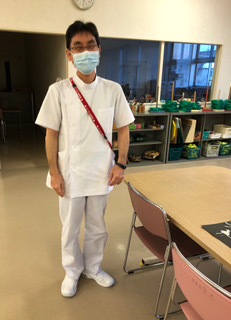
And so, for the next three to five months I will go to rehab several times a week. My wise therapist will massage, knead, pull and push. He will give me exercises that painfully stretch me further than I ever dreamed possible. And then he will tell me I am doing fine. And the next time will probably be better.
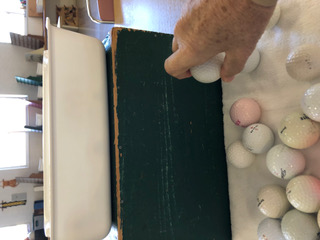
My friend was right. This is what it is. I have to accept where I am now, and move within the infinite possibilities it has to offer. These difficult challenges are indeed very inspiring.
Maybe this could also be a message for the world. We are where we are. We are in this together. What kind of inspiring future, for all, will each one of us in our daily lives create from the painful challenges we now face?
Love,
Anne
The challenges of the past year have been so complex and far-reaching that they stretch to the dimension of the archetypal. Ongoing tragedies abound. But through them, maybe because of them, many beautiful and inspiring stories also continue to unfold.
In light of the enormity of world changes, I often wonder where the vicissitudes of my teeny life fit into the larger scheme of things. How do any of us make a difference to the overall picture as we work our way through the demands and joys of each day?
A few weeks ago, I fell, severely hitting my upper arm and shoulder. Despite the fractured and dislocated femur, at first the doctor told me the bone should heal on its own and after that, with rehab, it would eventually find its way back into place. (A friend who broke her arm long before me was given the same advice by a different doctor. So, maybe this is common practice here.) I agreed to give it a try. But after a week, the bone had completely broken, twisted, and further removed itself from its shoulder home. I was immediately sent to the hospital.
And this is where small inspiring events began to unfold. The surgeon stayed late to meet me, explained what was in store, and sent me home to prepare for a rather lengthy hospital stay (long for foreign standards, rather short for Japanese). I checked in the following day.
A friend who lives in the apartment block I do said, “This is what it is. You have no choice. Just deal.” Her directness was solidifying. No complaining, no what if, no I shouldn’t have. Simply deal. That focus gave me tremendous courage, which I may not have otherwise had.
Another friend sent me daily short messages of encouragement. And once I was finally sent home, others filled my larder with food. Not once, but many times.
Back in the hospital, roommate was one of the warmest, most refined, yet genuine persons I have ever known. We kept the curtains around our beds open so we could chat, watch TV together, or silently appreciate the presence of one another.

The hospital itself was a world of its own. Of course, the staff worked on clock time, but the rest of us were definitely living in another dimension. I called it “God’s Time, the Wisdom of the Goddess”. Our job was to align ourselves with the forces of Nature so as to bring about our personal healing. Yet at the same time, we were like a team, holding each other together. There were no social boundaries, only a unified caring I had not experienced so fully since the earthquake and tsunami of 2011.
And yes, the nurses were unbelievable. No matter what time of day, or how busy they were, they always had a smile and were ready to help. Their lives were shining examples of unified selfless service. I had always admired the nursing profession, but after what I experienced, I can truly say they are angels on earth.
The halls were filled with medical equipment and we each used what we needed to the limits of our abilities. It was so touching to see how everyone encouraged each other. “You’re doing so well. Yesterday you were in a wheel chair, today a roll walker, surely soon it will be a cane.”

Each morning I got up early to walk the lobby before the hospital opened for the day. Japanese feel that healing is as much an emotional and spiritual matter as physical. So, that reception area was always filled with things of beauty. New Year decorations, banners, traditional kites. Throughout the year the displays would change with each season.


Everyone and everything has inspired me during this personally challenging time. But maybe my physiotherapist offered me an insight that will last the longest. “Don’t cringe and turn in upon yourself. Don’t lock yourself into the pain, lamenting what you can no longer do. Instead look within your limits and see the possibilities. You can, and will, do much more than you realize.”

And so, for the next three to five months I will go to rehab several times a week. My wise therapist will massage, knead, pull and push. He will give me exercises that painfully stretch me further than I ever dreamed possible. And then he will tell me I am doing fine. And the next time will probably be better.

My friend was right. This is what it is. I have to accept where I am now, and move within the infinite possibilities it has to offer. These difficult challenges are indeed very inspiring.
Maybe this could also be a message for the world. We are where we are. We are in this together. What kind of inspiring future, for all, will each one of us in our daily lives create from the painful challenges we now face?
Love,
Anne
Izunuma Marsh’s Yearly Guests
- At December 09, 2020
- By admin
- In Annes Letters
 0
0
Dear Family and Friends,
“Noriko, by chance, I have tomorrow off. Would you like to do something?”
“Sure, I’d love to. Where shall we go?”
At first, we thought of train hopping on local lines from Sendai to Fukushima in the south. But connections were both bad and infrequent. So, Noriko said, “If the south is not good, how about going in the opposite direction? Let’s go see birds.”



Being north, we figured it would be bitter cold, but to our delight it was warm in the sun. So much so we were able to have lunch outside. Noriko had bought a plant for her home, so we put it in the center of our table to add to the day’s beauty and joy.
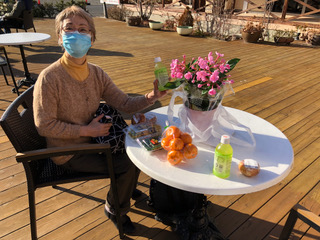

And after lunch, we headed for a hot spring bath. Being in the countryside, where the locals know every field and road, there were no signs. Before leaving, we had asked in the Visitors’ Center. By using the floor map, the guide literally walked us through the route. We thought we were fine. But we weren’t. So, we stopped by a farm to ask. No one was home. But finally, we met an old man and asked him.
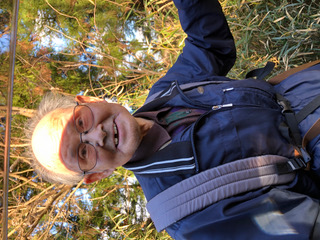
“What an honor to speak to such gorgeous women,” he said, whipping off his hat and smiling. In strong local dialect, he continued, “Now what was your question again. Oh, yes, that’s right. The spa is just down the road a piece. Now, if I walked it, it would take an hour or so, I imagine. So, in a car, ten minutes.” We giggled, thanked him, and drove off.
It was not ten minutes. Or twenty, for that matter. We drove and drove, figuring since it was the only road, it would have to be right. To reassure Noriko, I volunteered, “I get the feeling they don’t live by clocks here. Why bother if you have the sun, times of hunger, and the morning departure and evening return of birds to tell you the time of day?”
Eventually we came upon the spa, had a delicious bath, and reluctantly headed home. It was approaching dusk, with no road signs or lights, so we felt a bit vulnerable. But suddenly when we rounded a bend, we saw the sun setting and a cluster of birds magnificently silhouetted against the water and the sky.

“Noriko, by chance, I have tomorrow off. Would you like to do something?”
“Sure, I’d love to. Where shall we go?”
At first, we thought of train hopping on local lines from Sendai to Fukushima in the south. But connections were both bad and infrequent. So, Noriko said, “If the south is not good, how about going in the opposite direction? Let’s go see birds.”
And indeed, in northern Miyagi Prefecture there are several mashes where avian guests arrive every winter. They come from far away Siberia. Among many others, too numerous to name, there are ducks, geese, and occasionally gracious and beautiful swans. Locals have welcomed them for thousands of years.

This year, as every, they were very polite and kept social distance between one another, and us.
As soon as we arrived at Izunuma Marsh, we headed to the Visitors’ Center. It had a wide glass-walled room filled with educational displays. They were all good. But what probably delighted me most was the flooring, showing the aerial view of the whole locale, literally a birds’ eye view.

Another guest this year, unwanted, is Queen Corona. Because of her, the small library had all the books removed. But surely, they will be returned when this horrible Queen is finally dethroned.

Being north, we figured it would be bitter cold, but to our delight it was warm in the sun. So much so we were able to have lunch outside. Noriko had bought a plant for her home, so we put it in the center of our table to add to the day’s beauty and joy.

As we ate, we watched birds flying in perfect formation overhead.

And after lunch, we headed for a hot spring bath. Being in the countryside, where the locals know every field and road, there were no signs. Before leaving, we had asked in the Visitors’ Center. By using the floor map, the guide literally walked us through the route. We thought we were fine. But we weren’t. So, we stopped by a farm to ask. No one was home. But finally, we met an old man and asked him.

“What an honor to speak to such gorgeous women,” he said, whipping off his hat and smiling. In strong local dialect, he continued, “Now what was your question again. Oh, yes, that’s right. The spa is just down the road a piece. Now, if I walked it, it would take an hour or so, I imagine. So, in a car, ten minutes.” We giggled, thanked him, and drove off.
It was not ten minutes. Or twenty, for that matter. We drove and drove, figuring since it was the only road, it would have to be right. To reassure Noriko, I volunteered, “I get the feeling they don’t live by clocks here. Why bother if you have the sun, times of hunger, and the morning departure and evening return of birds to tell you the time of day?”
Eventually we came upon the spa, had a delicious bath, and reluctantly headed home. It was approaching dusk, with no road signs or lights, so we felt a bit vulnerable. But suddenly when we rounded a bend, we saw the sun setting and a cluster of birds magnificently silhouetted against the water and the sky.

We stopped, stood in amazement, took photos, and finally climbed back into the car and headed, a little more confidently, into the night.
Love,
Anne
Love,
Anne
New, but lifeless; shabby, but alive
- At November 12, 2020
- By admin
- In Annes Letters
 0
0
Dear Family and Friends,
As Biden talks about “The Soul of the Nation”, I would like to talk about “The Soul of the Future”. And to do that, I will turn to my neighborhood in Sendai.
Anything you say about Japan is true. And so is its opposite. Without a doubt, it is a country of many contradictions. Take gardens, for example. This country is renowned for ones that are carefully trimmed and raked, some going back hundreds, if not thousands of years. Yet, modern homes are some of the most barren imaginable with nothing green in sight, only blacktop or a parking lot smack up to the front door. Japanese say they love nature, but often when it comes to their homes, it is as if they want to kill anything alive that comes near. It seems in many cases, there is only verbal concern for global warming. And indeed, last summer with all the new roads and parking lots — and no trees — it was unbearably hot.
On the other hand, despite this deluge of new housing developments since the 2011 earthquake, leaving no free space anywhere, there are also many abandoned homes sprinkled all over the city. It is as if the inhabitants simply walked out, closed the door, and never came back. You can even see kitchen utensils still hanging in windows, or clothes waiting for the next day of work. Being Japan, there is no question of vandalism. So, these buildings remain, getting older and shabbier as the years go by. Their age and emptiness give an eerie feeling. But at the same time, the wildly overgrown gardens and rusty walls yield a sense of life and of mystery. Surely that is good for the imagination and the soul, don’t you think?
On the other hand, despite this deluge of new housing developments since the 2011 earthquake, leaving no free space anywhere, there are also many abandoned homes sprinkled all over the city. It is as if the inhabitants simply walked out, closed the door, and never came back. You can even see kitchen utensils still hanging in windows, or clothes waiting for the next day of work. Being Japan, there is no question of vandalism. So, these buildings remain, getting older and shabbier as the years go by. Their age and emptiness give an eerie feeling. But at the same time, the wildly overgrown gardens and rusty walls yield a sense of life and of mystery. Surely that is good for the imagination and the soul, don’t you think?
Other abodes are literal shacks, somehow standing, yet with people actually living in them. An old lady near me lives in one and says, “I am so blessed. I have a roof over my head that does not leak. My home is humble, but it is all I need.” She has an abundant garden, small, but full of vegetables and flowers. They match her positive attitude, and make her corner home be life-filled and forever joyous. In fact, she is known and loved all over the neighborhood. And she knows all of us in return.
This extreme contrast of inhabited, but lifeless homes, next to shacks or empty, but alive ones has led me on many photo explorations around my neighborhood. Here are a few of the shots so far. Maybe you will be as intrigued as I am in seeing of them, each with its unique presence and definite personality.
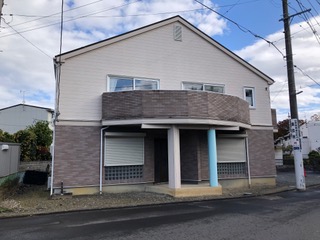
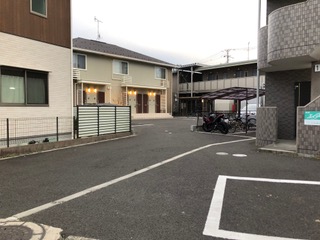
Where do the children play?

This extreme contrast of inhabited, but lifeless homes, next to shacks or empty, but alive ones has led me on many photo explorations around my neighborhood. Here are a few of the shots so far. Maybe you will be as intrigued as I am in seeing of them, each with its unique presence and definite personality.
Inhabited, but Lifeless
Front door literally on the main road

Not a tree in sight to celebrate the change of seasons

Where do the children play?

Uninhabited, but Alive


Even a bicycle is left as is

Beautiful rusty gate


Barely Standing, but Inhabited
Ivy covered shack, WiFi dish, new car

My grateful neighbor’s home and garden

My neighbor’s friend lives here.
“He and I moved to this neighborhood at the same time.
We have been friends for years.”
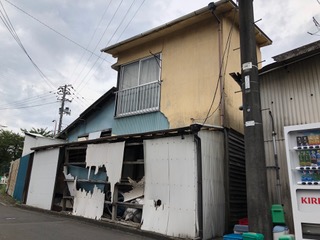
These photos seem to show that Japan, too, is a very divided society. The differences are not as loudly broadcast as in America, but they are there, and for the most part, accepted. There are the rich and the poor. Those who live in newness and comfort, next to those who reside in poverty. There are small developments with soulless homes popping up like mushrooms coupled with shacks and empty places filled to the brim with life of one form or another. The unifier in all this, though, is a deep sense of national identity. “We are Japanese and we are very proud of it.” I hope very soon Americans, with maturity and no embarrassment, will be able to say the same.
Love,
Anne
Seeking the Feminine
- At October 22, 2020
- By admin
- In Annes Letters
 0
0
Dear Family and Friends,
Recently several of my friends have mentioned the need for more Feminine, Yin energy in the world. “There is so much aggression. So much bullying. So much competition. So much distrust. So many wars. So much arrogance storming over facts and common sense so as to dominate the storyline. We need a softer touch. We need to switch to something more intuitive, more along the line of Yin.”
I fully agree with the devastating extremes stalking the world at this precarious time. And “We need more Feminine” sounds like a much-needed alternative. But when I ask myself, “But what exactly is ‘the Feminine’?” I realize I really am not so sure. So, I decided to open myself to feeling and observing my way through each day, seeing if I could clearly define “the Feminine” in this mixed up world of ours.
Today two friends and I decided to go for a hike. None of us had gone this year because of Corona, but we figured we would be fine being out in the open, away from others. We also planned to have a nice spa bath after the rigors of climbing a mountain.
All of us get along, but my two friends are particularly fond of each other. As soon as they saw one another, which had been over a year, they started talking. Well, not really talking. It was so delicate and fluttery, punctuated with little-girl giggles, that it was more like tiny birds chirping. They were so light and happy that they radiated pure joy.
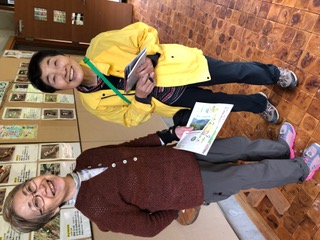
We had planned on taking a lift part way up the mountain, but when we arrived, we were told it was not working. But there was a nature center that we could check out for maps and information on trees, shrubs, birds, and other animals. So, we started there.

Immediately, my friends began oohing and aahing over absolutely every single thing we passed. Maybe it was teeny animals made out of forest seeds or comparative photos of male and female animals. Maybe it was stuffed specimens of local wildlife or maps of migratory routes of birds that go from Japan as far south as Australia or as far east as Hawaii. Then it was beetles and butterflies, an area for watching live birds coming to feed, and a computer program that had recordings of hundreds of local bird songs. No matter what, they stopped to inspect, push buttons, and play with every single thing in the entire building.
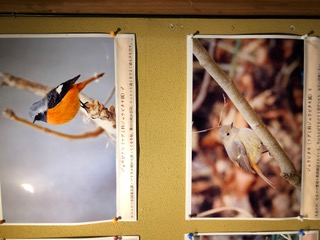
I soon realized our plan for a hike and getting home by 4 p.m. was out the window, so simply settled in to enjoy the slow pace, genuine curiosity, and delicate delight of my friends, while being interested in discovering what this hands-on museum had to offer. It was impressive and fun.
When we finally managed to pull ourselves away from the marvelous displays, my friends ceaselessly twittering the entire time, we decided to indeed take a short hike. But looking at the map took all three of us turning it this way and that, trying to figure what was in which direction. Happily for us, a group of 5th graders arrived with their digital map, doing a much better job of navigating than us.


Then for the bath, where my friends sat neck deep, still chattering away, until Noriko lay back on a rock and fell asleep, fully immersed except for her nose. I went outside to enjoy an outdoor soak.
It was dark by then. Noriko and I headed home, after saying good-bye to Keito, and immediately got lost on the winding country roads with no lights or signs. “Don’t worry,” she said. “This happens to me all the time. But things always work out.” And sure enough, they did. We got to Sendai safely and I arrived home with a huge daikon from a roadside stand, and packages of cheese and Japanese bean cakes to give away as gifts. Noriko had bought an entire box of local eggs, and she gave me a few.

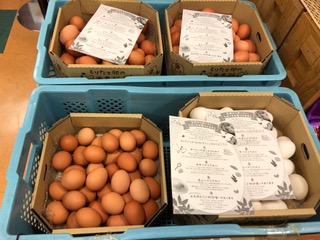
Today we did not follow a time schedule or a specific plan, but we were incredibly receptive and curious about everything that presented itself to us. No detail was missed or went unappreciated. We did not compete, but wove our comments into the general flow of the conversation. Each one of us felt part of a larger whole, whether that be our small group or the natural world around us. It was a beautiful day. And if that is, in part, what “the Feminine” means, I surely hope many will have the openness and sense of safety to enjoy it as we did today.
Love,
Anne
Recently several of my friends have mentioned the need for more Feminine, Yin energy in the world. “There is so much aggression. So much bullying. So much competition. So much distrust. So many wars. So much arrogance storming over facts and common sense so as to dominate the storyline. We need a softer touch. We need to switch to something more intuitive, more along the line of Yin.”
I fully agree with the devastating extremes stalking the world at this precarious time. And “We need more Feminine” sounds like a much-needed alternative. But when I ask myself, “But what exactly is ‘the Feminine’?” I realize I really am not so sure. So, I decided to open myself to feeling and observing my way through each day, seeing if I could clearly define “the Feminine” in this mixed up world of ours.
Today two friends and I decided to go for a hike. None of us had gone this year because of Corona, but we figured we would be fine being out in the open, away from others. We also planned to have a nice spa bath after the rigors of climbing a mountain.
All of us get along, but my two friends are particularly fond of each other. As soon as they saw one another, which had been over a year, they started talking. Well, not really talking. It was so delicate and fluttery, punctuated with little-girl giggles, that it was more like tiny birds chirping. They were so light and happy that they radiated pure joy.

We had planned on taking a lift part way up the mountain, but when we arrived, we were told it was not working. But there was a nature center that we could check out for maps and information on trees, shrubs, birds, and other animals. So, we started there.

Immediately, my friends began oohing and aahing over absolutely every single thing we passed. Maybe it was teeny animals made out of forest seeds or comparative photos of male and female animals. Maybe it was stuffed specimens of local wildlife or maps of migratory routes of birds that go from Japan as far south as Australia or as far east as Hawaii. Then it was beetles and butterflies, an area for watching live birds coming to feed, and a computer program that had recordings of hundreds of local bird songs. No matter what, they stopped to inspect, push buttons, and play with every single thing in the entire building.

I soon realized our plan for a hike and getting home by 4 p.m. was out the window, so simply settled in to enjoy the slow pace, genuine curiosity, and delicate delight of my friends, while being interested in discovering what this hands-on museum had to offer. It was impressive and fun.
When we finally managed to pull ourselves away from the marvelous displays, my friends ceaselessly twittering the entire time, we decided to indeed take a short hike. But looking at the map took all three of us turning it this way and that, trying to figure what was in which direction. Happily for us, a group of 5th graders arrived with their digital map, doing a much better job of navigating than us.

But instead of heading up the mountain, as I had expected, we veered the other way and our “hike” ended about ten minutes later.
“Time for lunch,” Noriko announced. So, we piled into her car and found a nice restaurant specializing in local cheese dishes. They ordered a sandwich because they would get free soup, but I could not resist braving the Japanese flavored pizza. It sounded so strange with its soy sauce and seaweed, making for an unusual East-West combination.
“Time for lunch,” Noriko announced. So, we piled into her car and found a nice restaurant specializing in local cheese dishes. They ordered a sandwich because they would get free soup, but I could not resist braving the Japanese flavored pizza. It sounded so strange with its soy sauce and seaweed, making for an unusual East-West combination.

Then for the bath, where my friends sat neck deep, still chattering away, until Noriko lay back on a rock and fell asleep, fully immersed except for her nose. I went outside to enjoy an outdoor soak.
It was dark by then. Noriko and I headed home, after saying good-bye to Keito, and immediately got lost on the winding country roads with no lights or signs. “Don’t worry,” she said. “This happens to me all the time. But things always work out.” And sure enough, they did. We got to Sendai safely and I arrived home with a huge daikon from a roadside stand, and packages of cheese and Japanese bean cakes to give away as gifts. Noriko had bought an entire box of local eggs, and she gave me a few.


Today we did not follow a time schedule or a specific plan, but we were incredibly receptive and curious about everything that presented itself to us. No detail was missed or went unappreciated. We did not compete, but wove our comments into the general flow of the conversation. Each one of us felt part of a larger whole, whether that be our small group or the natural world around us. It was a beautiful day. And if that is, in part, what “the Feminine” means, I surely hope many will have the openness and sense of safety to enjoy it as we did today.
Love,
Anne
Alphabet of Laughter
- At October 09, 2020
- By admin
- In Annes Letters
 0
0
Dear Family and Friends,
Japanese culture is a blend of almost everything and its opposite. Actions and reactions can range from the most rigid to the most spontaneous and free. Rules can be narrow and severe, but they are often balanced by unexpected lightness and humor. More than a 1000 years ago this equilibrium was well established, even to the point of how people laughed.

The Japanese alphabet, あ、い、う、え、お, (ah, ee, oo, eh, oh) is the basis for categorizing laughter.
あ becomes HaHaha
い makes HeHeHe
う produces WhoWhoWho
え yields HeyHeyHey
お is HoHoHo

How do these utterances correspond to proper etiquette?
あ HaHaHa is how we naturally laugh.
い HeHeHe is a response of ridicule, as if we are looking down on someone, making fun of him.
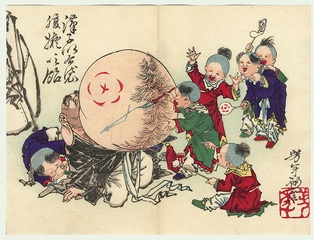
お HoHoHo is for the highest levels of society, and hence the most subtle and polite. Of course, it is performed softly, with your head bowed, and the tips of your fingers covering your mouth.
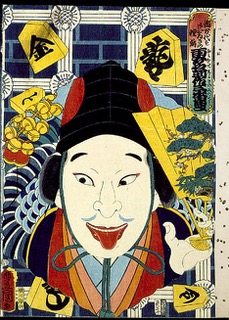
Japanese culture is a blend of almost everything and its opposite. Actions and reactions can range from the most rigid to the most spontaneous and free. Rules can be narrow and severe, but they are often balanced by unexpected lightness and humor. More than a 1000 years ago this equilibrium was well established, even to the point of how people laughed.

Hotei, God of Laughter
The Japanese alphabet, あ、い、う、え、お, (ah, ee, oo, eh, oh) is the basis for categorizing laughter.
あ becomes HaHaha
い makes HeHeHe
う produces WhoWhoWho
え yields HeyHeyHey
お is HoHoHo

Image by Hokusai
How do these utterances correspond to proper etiquette?
あ HaHaHa is how we naturally laugh.
い HeHeHe is a response of ridicule, as if we are looking down on someone, making fun of him.
It is also often used in moments of embarrassment, as a somewhat shaky, fluttering utterance. Naturally, your head is lowered, your eyes closed, and your mouth covered.
う WhoWhoWho is a very polite tittering, with your eyes lowered, your mouth covered with the tips of your fingers.
え HeyHeyHey is reserved for comedies and ridiculous situations.
う WhoWhoWho is a very polite tittering, with your eyes lowered, your mouth covered with the tips of your fingers.
え HeyHeyHey is reserved for comedies and ridiculous situations.

お HoHoHo is for the highest levels of society, and hence the most subtle and polite. Of course, it is performed softly, with your head bowed, and the tips of your fingers covering your mouth.
Most people these days do not consciously know these rules. But after centuries of practice, many of these responses have become innate. So, old ladies politely titter while covering their mouths. Young and middle-aged men respond spontaneously and loudly when drinking together after work. And junior high school girls with a fluttering HeHeHe respond shyly to a question in class.
In this era of much needed humor, I challenge you to find varieties of laughter among your friends and in your own culture. Some will be familiar and overt, others might be surprising, subtle and subdued. But each one, is surely an integral part and small reflection of these incredibly complex times we share.
Love,
Anne
In this era of much needed humor, I challenge you to find varieties of laughter among your friends and in your own culture. Some will be familiar and overt, others might be surprising, subtle and subdued. But each one, is surely an integral part and small reflection of these incredibly complex times we share.
Love,
Anne

The Ground We Stand On
- At September 08, 2020
- By admin
- In Annes Letters
 2
2
September 8, 2020
Dear Family and Friends,
Dear Family and Friends,
Stories and imagination are crucial for our survival, for piecing together the fragments of our lives, for giving us a sense of meaning and maybe even purpose.
The other day a friend took me to a museum in Sendai that I had heard about, but had never been to. At first blush it seemed rather small and plain, but behind that apparent simplicity were astonishing discoveries.
The museum was constructed over land that a farmer had hoped to turn into a rice paddy. Now it is fully within city limits, but remains an island of green surrounded by apartments, several bus stops, a subway station, and even a large shopping mall.
Several years ago, a farmer was opening land for planting when he hit a hard object. As he dug, he sensed he had come upon something extensive and very rare, and maybe important. So, he informed city officials of his find. Sure enough, it turned out he had encountered the 20,000-year-old remains of Paleolithic trees.

Soon scientists began the work of uncovering this remarkable discovery. And to their amazement, they found not only a maze of trees and their roots, but also the remains of a camp fire and a small hole filled with stone tools. They also found pine cones and animal spores containing seeds of flowers, grasses, and various trees. Those precious finds allowed them to piece together an understanding of life at that time.
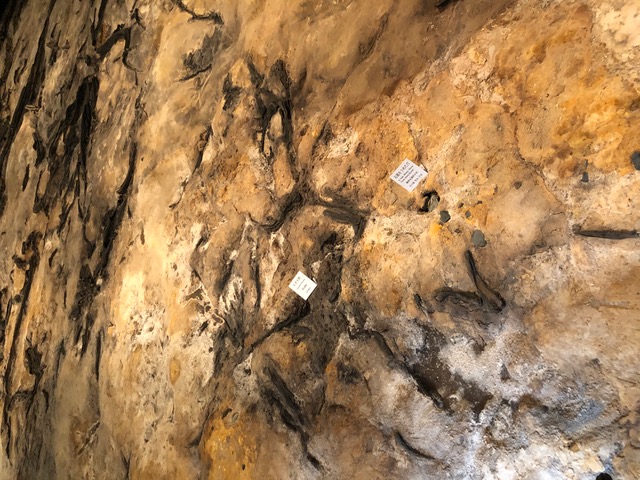
(The square sign on the left indicates the remains of a campfire. The one on the right marks a hole filled with stone tools. They were left exactly as they were found.)
People then were hunters-gatherers. The area was much cooler than it is now, so the vegetation was different. And since more land was exposed because of glaciers, there was more area for animals to roam and hunters to follow them.
Surely, on the exact spot where the museum stands today, a few hunters had paused, maybe to rest, maybe to make tools, maybe to spend the night. We cannot know. But they did leave a few traces, which now serve as a remarkable link to a mysterious part of the earth’s and humanity’s ancient past.
Now, on the museum grounds is a replicated Paleolithic forest with trees, shrubs, grasses, and marshes typical of that era. This natural environment adds greatly to the awe-inspiring experience of viewing such ancient remains.
And upstairs above the actual trees, there is a small, but informative museum of artifacts and other findings from the Paleolithic Era and later. It was very humbling to be standing over land that has known humans for over 20,000 years, to see the tools people of that time actually used, and to imagine the harsh life they lived.
People then were hunters-gatherers. The area was much cooler than it is now, so the vegetation was different. And since more land was exposed because of glaciers, there was more area for animals to roam and hunters to follow them.
Surely, on the exact spot where the museum stands today, a few hunters had paused, maybe to rest, maybe to make tools, maybe to spend the night. We cannot know. But they did leave a few traces, which now serve as a remarkable link to a mysterious part of the earth’s and humanity’s ancient past.
Now, on the museum grounds is a replicated Paleolithic forest with trees, shrubs, grasses, and marshes typical of that era. This natural environment adds greatly to the awe-inspiring experience of viewing such ancient remains.
And upstairs above the actual trees, there is a small, but informative museum of artifacts and other findings from the Paleolithic Era and later. It was very humbling to be standing over land that has known humans for over 20,000 years, to see the tools people of that time actually used, and to imagine the harsh life they lived.
This museum, small as it is, is an impressive reminder of nature’s and humanity’s remarkable evolving together through time. And thus, maybe now more so than ever, it remains a noteworthy wonder, not only for Japan, but for the entire world.
Love,
Anne
Healing
- At September 01, 2020
- By admin
- In Annes Letters
 0
0
September 1, 2020
Dear Family and Friends,
Ito San is a friend. She has her own travel agency, which these days is suffering badly. Even so, she has kept her place open, works hard, and hopes for the best. Prime Minister Shinzo Abe, before he resigned, started the “Go-To” program, making trips nationwide (except Tokyo) be half price. So, the government is on her side. I wanted to help her, too. But how? I listen to so much American news that I am rigid with concern about the Coronavirus, even though here in the northeast of Japan cases are very few.
I went to discuss with Ito San what I could do for her, where I could go and feel safe. “I know of two wonderful spas that you will love,” she told me. “One has an easy hiking course nearby and the other is renowned for its healing properties. Yes, I think they will be perfect for you.”
I was still a bit apprehensive, though. But Ito San reassured me. “First of all, not many will be traveling. And the ones that do will follow basic rules: masks, social distancing, hand washing. Buses now pump in fresh air from the outside every 5 or 10 minutes, plus you have stops when you can get out for more fresh air. Don’t worry. You will be fine.”

Dear Family and Friends,
Ito San is a friend. She has her own travel agency, which these days is suffering badly. Even so, she has kept her place open, works hard, and hopes for the best. Prime Minister Shinzo Abe, before he resigned, started the “Go-To” program, making trips nationwide (except Tokyo) be half price. So, the government is on her side. I wanted to help her, too. But how? I listen to so much American news that I am rigid with concern about the Coronavirus, even though here in the northeast of Japan cases are very few.
I went to discuss with Ito San what I could do for her, where I could go and feel safe. “I know of two wonderful spas that you will love,” she told me. “One has an easy hiking course nearby and the other is renowned for its healing properties. Yes, I think they will be perfect for you.”
I was still a bit apprehensive, though. But Ito San reassured me. “First of all, not many will be traveling. And the ones that do will follow basic rules: masks, social distancing, hand washing. Buses now pump in fresh air from the outside every 5 or 10 minutes, plus you have stops when you can get out for more fresh air. Don’t worry. You will be fine.”

She was right. There were all of three of us on the highway bus, and about five on the local bus to the first spa. So, social distancing was easy.

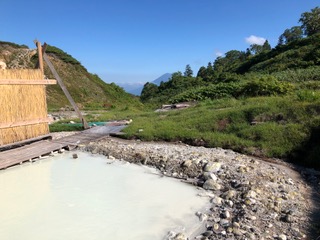
I hiked the second day through a gorgeous landscape dotted with small crater lakes.


Later I went over the mountain to the medicinal spa. It was very different because most of the guests were people with serious illnesses. Yet, they were also some of the most lovely. “We are all sick here,” one said to me, “so we must be kind to each other. We must help each other. Otherwise, how could we live with hope?”

I sat in those baths, in a building made of cedar wood, smelling both earthy and divine. This was my third day of soaking, and I began to realize that over that time, I myself had gradually started to heal. I sensed how my body had quietly opened up, releasing tensions so deep they had always seemed part of the make-up of who I was. I thought about all the people who had kindly helped me, either with confusing bus changes or with proper ways to drink sulfur water to cleanse my body inside, just as the baths were outside.
As I reflected on these things, I heard myself saying, “So, this is what healing means. It is people accepting basic guidelines for safety, and graciously working together to make sure everyone is all right and supported.
Then I thought of the spas themselves. Hot healing waters rising up from deep within the earth. Coupled with our openness to let go of what we thought defined us and fully accept what is offered so abundantly and graciously.
Can our very troubled world do this? Can we move into a consciousness of truly wanting healing, a healing that rises up from deep within? Can we grow in maturity enough to work hard for it together, and then allow it to happen?
Love,
Anne
(Besides, how could I not feel safe with a truck like this in front of my bus?)

The hotel itself was on the edge of a National Park. It had mostly outdoor baths. They were literally boiling hot, but had piercingly cold water from mountain streams flowing into them to make the heat bearable. The water was a murky white because of volcanic ash. It supposedly had healing properties, so people would eagerly pack it onto their faces and bodies. And sure enough, after doing so, my own skin felt remarkably soft and smooth.

I hiked the second day through a gorgeous landscape dotted with small crater lakes.

And in the evening, I was back in the baths, looking at the star-filled sky. The following day, before dawn, I headed to the eastern bath to watch the sunrise.

Later I went over the mountain to the medicinal spa. It was very different because most of the guests were people with serious illnesses. Yet, they were also some of the most lovely. “We are all sick here,” one said to me, “so we must be kind to each other. We must help each other. Otherwise, how could we live with hope?”

I sat in those baths, in a building made of cedar wood, smelling both earthy and divine. This was my third day of soaking, and I began to realize that over that time, I myself had gradually started to heal. I sensed how my body had quietly opened up, releasing tensions so deep they had always seemed part of the make-up of who I was. I thought about all the people who had kindly helped me, either with confusing bus changes or with proper ways to drink sulfur water to cleanse my body inside, just as the baths were outside.
As I reflected on these things, I heard myself saying, “So, this is what healing means. It is people accepting basic guidelines for safety, and graciously working together to make sure everyone is all right and supported.
Then I thought of the spas themselves. Hot healing waters rising up from deep within the earth. Coupled with our openness to let go of what we thought defined us and fully accept what is offered so abundantly and graciously.
Can our very troubled world do this? Can we move into a consciousness of truly wanting healing, a healing that rises up from deep within? Can we grow in maturity enough to work hard for it together, and then allow it to happen?
Love,
Anne
A Hymn to Space
- At August 19, 2020
- By admin
- In Annes Letters
 0
0
August 19, 2020
Dear Family and Friends,
Please forgive me if this letter is a tad trite. However, for the past four years, I have been struggling to give some sort of understanding and order to the chaotic changes that have been happening worldwide. Viewing my own country in particular has been both embarrassing and alarming. But that, too, has motivated me to continually evolve a philosophy that sees what is happening, while attempting to incorporate the many shattered fragments into some sort of cohesive whole.
Adding to that endeavor, yesterday as I listened discussions analyzing the Democratic National Convention, I heard several commentators say, “It is going to get worse before it gets better.” Maybe such predictions are a way to steel us, to encourage us not to give up, as we, peoples everywhere, work towards the dream of a better future for all.
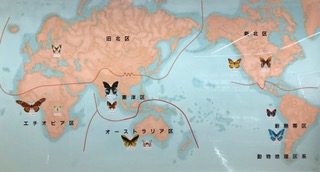

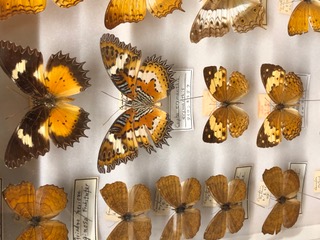

As I was exploring in complete wonder and amazement, my breath taken away at every turn, I thought, why not reverse yesterday’s political comment? Instead of thinking that things have to get worse, why not start from a completely different place? “When we think things can’t get more beautiful, to our surprise, they do.”

And sure enough, at the exit of this impressive display of world splendor, there was an art piece called “A Hymn to Space”. It depicted the cosmos via an assemblage of butterfly wings. One hundred species, over 7,000 wings came together to make a gorgeous, harmonious, breathtaking whole.

What is the personal story behind this glowing creation? Many years ago, a young boy named Kunio Karasuyama, wrote to Buzno Kamei, asking him if they could exchange a few butterflies. Mr. Kamei kindly obliged. That happy exchange started a life-long friendship. When he grew up, that young boy became a Catholic priest in Nagasaki. But one year he came to Sendai to honor his friend. He created this truly stunning testament to what is possible when separate individuals come together with a common purpose for a higher beauty, a higher good, a higher standard for all.

I hope this reverse mantra — “When we think things can’t get more beautiful, to our surprise, they do.” — will catch hold of the world’s psyche. Then, out of distrust, destruction, and despair we can create something profoundly inspiring and hope-filled for many, many generations to come.

Love,
Anne
Dear Family and Friends,
Please forgive me if this letter is a tad trite. However, for the past four years, I have been struggling to give some sort of understanding and order to the chaotic changes that have been happening worldwide. Viewing my own country in particular has been both embarrassing and alarming. But that, too, has motivated me to continually evolve a philosophy that sees what is happening, while attempting to incorporate the many shattered fragments into some sort of cohesive whole.
Adding to that endeavor, yesterday as I listened discussions analyzing the Democratic National Convention, I heard several commentators say, “It is going to get worse before it gets better.” Maybe such predictions are a way to steel us, to encourage us not to give up, as we, peoples everywhere, work towards the dream of a better future for all.
In contrast, today a friend and I met to celebrate her newly earned Master’s Degree. She is 57. In Japan attending graduate school so late in life is very rare. Yet, not only did she graduate, she also secured a very good job related to her field of research.
Part of today’s celebration was to go to a small, not well-known museum right near Sendai Station. A man named Bunzo Kamei was part of a family business called the Kamei Corporation. In fact, he was its third president. Of course, he was very involved in that all-consuming work, but his real love, a hobby since childhood, was collecting butterflies. And when he died, this kind gentleman left his entire collection to the company, which displays it on the top floor of its office building.
The collection is unbelievable.
Part of today’s celebration was to go to a small, not well-known museum right near Sendai Station. A man named Bunzo Kamei was part of a family business called the Kamei Corporation. In fact, he was its third president. Of course, he was very involved in that all-consuming work, but his real love, a hobby since childhood, was collecting butterflies. And when he died, this kind gentleman left his entire collection to the company, which displays it on the top floor of its office building.
The collection is unbelievable.
To start, there is a map of where the specimens come from. It may not look like much, but from each place Mr. Kamei collected a wide variety of some truly remarkable examples.

There is one display after another, and then yet another and another.

They go from the simplest and smallest to the grandest, most stunning creatures imaginable.



And everything in between.

As I was exploring in complete wonder and amazement, my breath taken away at every turn, I thought, why not reverse yesterday’s political comment? Instead of thinking that things have to get worse, why not start from a completely different place? “When we think things can’t get more beautiful, to our surprise, they do.”

And sure enough, at the exit of this impressive display of world splendor, there was an art piece called “A Hymn to Space”. It depicted the cosmos via an assemblage of butterfly wings. One hundred species, over 7,000 wings came together to make a gorgeous, harmonious, breathtaking whole.

What is the personal story behind this glowing creation? Many years ago, a young boy named Kunio Karasuyama, wrote to Buzno Kamei, asking him if they could exchange a few butterflies. Mr. Kamei kindly obliged. That happy exchange started a life-long friendship. When he grew up, that young boy became a Catholic priest in Nagasaki. But one year he came to Sendai to honor his friend. He created this truly stunning testament to what is possible when separate individuals come together with a common purpose for a higher beauty, a higher good, a higher standard for all.

I hope this reverse mantra — “When we think things can’t get more beautiful, to our surprise, they do.” — will catch hold of the world’s psyche. Then, out of distrust, destruction, and despair we can create something profoundly inspiring and hope-filled for many, many generations to come.

Love,
Anne
School Patrol Grandpa
- At August 03, 2020
- By admin
- In Annes Letters
 0
0
Dear Family and Friends,
In a recent letter, I shared a few local treasures that always bring a smile. One of them was School Patrol Grandpa. I am sure you remember him.

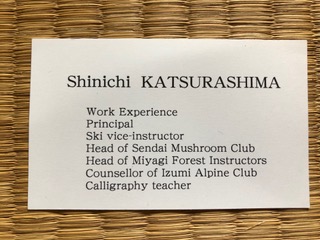
One thing he appreciates about his daily, varied routine is that it allows him to regularly get out of his home, feel in circulation with society, and have a very important and meaningful purpose to his life. To add to the sense of connection and purpose, along with bugs or mushrooms, he always brings a diary, which the neighborhood adds to daily. And he proudly shows off all the signatures, pictures, origami, and photos that fill the pages.
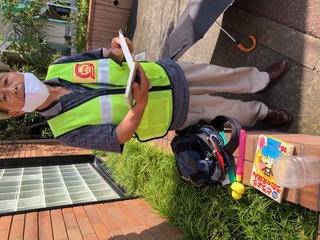
The kids, too, benefit, of course. Besides always having something to marvel at or to share, Grandpa teaches them much more. Even without meaning to, he teaches not the duty of respect for elders, but the pleasure in doing so. Yes, he so beautifully offers the crucial perspective that acknowledging, appreciating, and conversing with an oldster need not be an obligation, but uplifting, genuine delight.

Love,
Anne
In a recent letter, I shared a few local treasures that always bring a smile. One of them was School Patrol Grandpa. I am sure you remember him.

Since taking that photo, I have learned that Grandpa’s name is Katsurashima Shinichi and he is 86 years old. He has been a patrol volunteer for well over ten years and adores bringing wonder and surprise, not only to the kids rushing to school, but also to the moms and other passersby, including me. And his list of accomplishments is impressive, including a name card in English!

One thing he appreciates about his daily, varied routine is that it allows him to regularly get out of his home, feel in circulation with society, and have a very important and meaningful purpose to his life. To add to the sense of connection and purpose, along with bugs or mushrooms, he always brings a diary, which the neighborhood adds to daily. And he proudly shows off all the signatures, pictures, origami, and photos that fill the pages.

The kids, too, benefit, of course. Besides always having something to marvel at or to share, Grandpa teaches them much more. Even without meaning to, he teaches not the duty of respect for elders, but the pleasure in doing so. Yes, he so beautifully offers the crucial perspective that acknowledging, appreciating, and conversing with an oldster need not be an obligation, but uplifting, genuine delight.

Love,
Anne
Smiles & Laughter
- At July 21, 2020
- By admin
- In Annes Letters
 0
0
July 21, 2020
Dear Family and Friends,
The wisdom of the I Ching says, “When you cry, part of it is laughter.” (Hexagram 45). And it seems that is exactly what we need in this era of uncertainty and tumultuous upheaval. Laughter and tenderness, gentleness of understanding, enjoying the simple delights of life. So, here are few to share with you today.
My neighbors’ greeting at the front door

And from my veranda

Hitting the Road in Style at Any Age
(Can’t leave Mickey or Pooh behind!)

School Patrol Grandpa
(Always with a surprise for the kids — and adults)

And then there are signs.
West Meets East
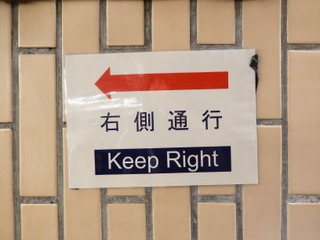
Politeness on the Train
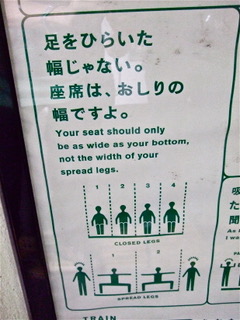
And on the Street
For Plants

And in Train Stations
(This station is open-air. The light fixture is right over the platform where waiting passengers stand)

And Finally, the Buddha
Everywhere

And Gently So

Love,
Anne
Dear Family and Friends,
The wisdom of the I Ching says, “When you cry, part of it is laughter.” (Hexagram 45). And it seems that is exactly what we need in this era of uncertainty and tumultuous upheaval. Laughter and tenderness, gentleness of understanding, enjoying the simple delights of life. So, here are few to share with you today.
My neighbors’ greeting at the front door

And from my veranda

Hitting the Road in Style at Any Age
(Can’t leave Mickey or Pooh behind!)

School Patrol Grandpa
(Always with a surprise for the kids — and adults)

And then there are signs.
West Meets East

Politeness on the Train

And on the Street
For People


For Plants

And in Train Stations
(This station is open-air. The light fixture is right over the platform where waiting passengers stand)

And Finally, the Buddha
Everywhere

And Gently So

Please enjoy your day.
Love,
Anne
Buddhist Flowers & a Shinto Circle
- At July 06, 2020
- By admin
- In Annes Letters
 0
0
July 6, 2020
Dear Family and Friends,
It is now the rainy season in Japan. Unlike in tropical climates, where storms thunder down, regular as clockwork, and then exit until the following day, here the season means clouds and very wet weather for almost six straight weeks. For us humans, it can become very heavy and draining, but the rice loves it. And so do the hydrangeas, renown here in Japan.
Even though Queen Corona is more-or-less under control here, we still take every precaution possible. That means, for one, most university classes are still online. My students and I are getting used to it, even when the system does not work very well and we can only get muffled voices and blurred faces on the screen. We are learning tolerance, probably they more with me, as I stumble along blindly, often asking for their help.
When I have a day ahead facing the computer, I like to bracket that focused, eye-straining experience with something that soothes. So, in the early morning I try to surround myself with beauty. I am fortunate to live near a Buddhist temple that at the moment is like a basket overflowing with huge round flowers. The varieties and colors are breathtaking. Even though I have been going there for years, many times a week in this season, I am always humbled by the sheer abundance and beauty of these gems. Nature can be so generous, give so freely. After wandering though corridors of these flowers, I return home calm and ready for the day.
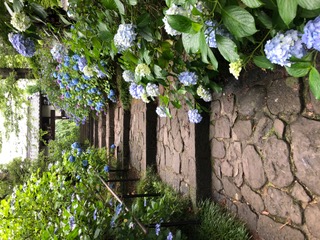

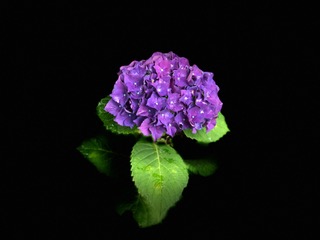
In the evening, I most often have a headache, so am delighted to head out once again. This time I go down small side streets, enjoying gardens and the quietness of places off the beaten track. I usually swing up to a Shinto shrine that is on the other side of my home from the morning’s temple. It has a big red Tori gate, a long flight of stairs, two fierce guardians to pass between, and finally the main shrine. This evening I was confronted with something unexpected, a large circle made of bamboo and grasses. I have seen these before, but very rarely, usually for special occasions only. Of course, I went to inspect.

There was a sign.
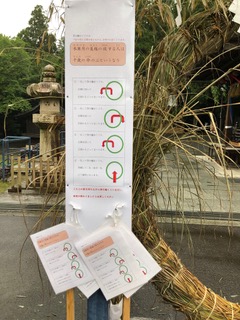
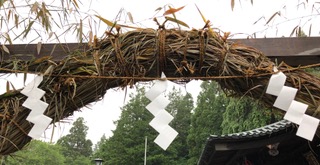
Love,
Anne
Dear Family and Friends,
It is now the rainy season in Japan. Unlike in tropical climates, where storms thunder down, regular as clockwork, and then exit until the following day, here the season means clouds and very wet weather for almost six straight weeks. For us humans, it can become very heavy and draining, but the rice loves it. And so do the hydrangeas, renown here in Japan.
Even though Queen Corona is more-or-less under control here, we still take every precaution possible. That means, for one, most university classes are still online. My students and I are getting used to it, even when the system does not work very well and we can only get muffled voices and blurred faces on the screen. We are learning tolerance, probably they more with me, as I stumble along blindly, often asking for their help.
When I have a day ahead facing the computer, I like to bracket that focused, eye-straining experience with something that soothes. So, in the early morning I try to surround myself with beauty. I am fortunate to live near a Buddhist temple that at the moment is like a basket overflowing with huge round flowers. The varieties and colors are breathtaking. Even though I have been going there for years, many times a week in this season, I am always humbled by the sheer abundance and beauty of these gems. Nature can be so generous, give so freely. After wandering though corridors of these flowers, I return home calm and ready for the day.



In the evening, I most often have a headache, so am delighted to head out once again. This time I go down small side streets, enjoying gardens and the quietness of places off the beaten track. I usually swing up to a Shinto shrine that is on the other side of my home from the morning’s temple. It has a big red Tori gate, a long flight of stairs, two fierce guardians to pass between, and finally the main shrine. This evening I was confronted with something unexpected, a large circle made of bamboo and grasses. I have seen these before, but very rarely, usually for special occasions only. Of course, I went to inspect.

There was a sign.

It said that the purpose of this sacred item was to pray for those suffering from the Coronavirus and for the earth’s healing from this terrible unwanted intruder. It gave clear instructions how to perform our walking, weaving prayer. We were to bow, pass through the circle, turn left, and back to where we started. Then do the same, going right, praying the entire time. We go left again. And finally, we bow, clap twice, step through the circle a final time and carry our prayers out into the world.

I do not know if this will encourage any physical cures. But I do trust that such sincerely performed rituals change energy fields, bringing us into greater inner harmony so we can deal with life with greater equanimity, courage, and hope.
Love,
Anne
Dog of Love
- At June 17, 2020
- By admin
- In Annes Letters
 0
0
June 17, 2020
Dear Family and Friends,
Last night I headed off to my recently reopened Tai Chi class. Queen Corona has not visited this prefecture of over six weeks, so we all feel confident going again, but of course, remain vigilant. Naturally, all of us are in a state of mild euphoria to be back together and to be able to stretch our limbs in ways we have not had privileged to for weeks.
And with that, I patted the truly Golden Retriever once more, and we went our separate ways. That evening, throughout the night, and even up to this very moment, I feel the gentle, yet radiant Light which that humble and loving creature so generously bestowed.
Love,
Anne

Dear Family and Friends,
Last night I headed off to my recently reopened Tai Chi class. Queen Corona has not visited this prefecture of over six weeks, so we all feel confident going again, but of course, remain vigilant. Naturally, all of us are in a state of mild euphoria to be back together and to be able to stretch our limbs in ways we have not had privileged to for weeks.
As I approached the Budokan, I saw a dog and his owner out for an evening stroll. This pet was unusual in that she stopped in her tracks, one leg almost raised, and stared at me with great intensity, blended with a hint of curiosity. I sensed she was not preparing to attack and I realized if I greeted her, her alert suspension would probably break. So, with my hand outstretched, low and palm down, I slowly approached as I cooed my hello to her. She immediately surrendered, let me come close, and sniffed my hand. When I was approved, she began to shimmer all over with excitement. I massaged behind her ears and patted her head as I continued almost singing to her. She was so delighted she glowed.
I turned to her owner and said, “You are so blessed to live in a house filled with love because of this truly beautiful animal.” “Yes,” he replied. “She is so open, so friendly, so trusting. We are indeed a lucky family.”
I turned to her owner and said, “You are so blessed to live in a house filled with love because of this truly beautiful animal.” “Yes,” he replied. “She is so open, so friendly, so trusting. We are indeed a lucky family.”
And with that, I patted the truly Golden Retriever once more, and we went our separate ways. That evening, throughout the night, and even up to this very moment, I feel the gentle, yet radiant Light which that humble and loving creature so generously bestowed.
Love,
Anne

Donuts, Apples, and Generosity
- At June 06, 2020
- By admin
- In Annes Letters
 0
0
Dear Family and Friends,
Every few months there is a young man who parks his flashy pink truck in the parking lot of the supermarket near my home. He is the Donut Man. He usually sells his wares to hungry kids coming home from school. But he also has goods that are healthy and homemade, things direct from local farms. I always peer in to see what he has, and we end up chatting. He loves giving me impromptu Japanese lessons, smiling as he teaches me the very local dialect that is found on the farms around Sendai.
The last time we met, I asked him how business was since I had not seen him for many months. “Has the Coronavirus prevented you from coming?” I queried. “Not so much. I don’t come to Sendai so often anymore because I prefer the country,” he replied. “People in Sendai are a bit shy and don’t buy much, but rural folk are really different. They live in huge houses, often with three generations, and will buy about 30 or 40 donuts at one time. Then they call their neighbors and invite them over after a day of work in the fields. They talk, drink sake, eat donuts, and have a marvelous time. I just love the atmosphere of openness and generosity of those folks. I laugh a lot, too, so I feel good.”

The other day a friend called and asked if I wanted to work on an apple farm for a day. I had been there last autumn to help trim leaves and turn each precious globe of fruit so that it would ripen evenly all the way round. I enjoyed that day a lot, so agreed to go, even though I had no idea what the work would entail this spring.
It turned out that we would remove all but the best baby apple in each cluster. That would allow the chosen one to get the sunshine and space that it would need to become gloriously round and red by the fall. They were Fuji apples, which are a favorite, so I was delighted to carefully prepare their environment for the best possible results.

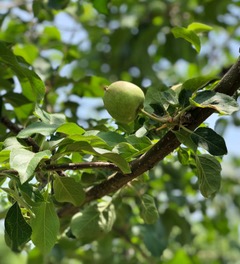
My friends, the farmers, and I snipped and clipped, crouching low, climbing high to do the best job we could.
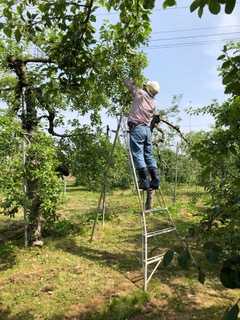


As we sat eating, the farmers asked me where I came from. I explained that I had grown up in what was then a farming area, where there had been apples. “But we never tended to them as meticulously as you do here,” I said. “The work we do for these Fuji is nothing to what we do for the Mutsu apples up the hill,” one man replied. “After we cut away all but the single best of a cluster, we put a special bag over it to protect it from insects. Those babies grow gorgeously huge and round. We sell them to China for over $100 a piece.” Needless to say, I was astonished.
After lunch and a nap under a tree, we resumed our labors for much of the afternoon. And of course, after a few hours, the women returned with snacks.

Every few months there is a young man who parks his flashy pink truck in the parking lot of the supermarket near my home. He is the Donut Man. He usually sells his wares to hungry kids coming home from school. But he also has goods that are healthy and homemade, things direct from local farms. I always peer in to see what he has, and we end up chatting. He loves giving me impromptu Japanese lessons, smiling as he teaches me the very local dialect that is found on the farms around Sendai.
The last time we met, I asked him how business was since I had not seen him for many months. “Has the Coronavirus prevented you from coming?” I queried. “Not so much. I don’t come to Sendai so often anymore because I prefer the country,” he replied. “People in Sendai are a bit shy and don’t buy much, but rural folk are really different. They live in huge houses, often with three generations, and will buy about 30 or 40 donuts at one time. Then they call their neighbors and invite them over after a day of work in the fields. They talk, drink sake, eat donuts, and have a marvelous time. I just love the atmosphere of openness and generosity of those folks. I laugh a lot, too, so I feel good.”

The other day a friend called and asked if I wanted to work on an apple farm for a day. I had been there last autumn to help trim leaves and turn each precious globe of fruit so that it would ripen evenly all the way round. I enjoyed that day a lot, so agreed to go, even though I had no idea what the work would entail this spring.
It turned out that we would remove all but the best baby apple in each cluster. That would allow the chosen one to get the sunshine and space that it would need to become gloriously round and red by the fall. They were Fuji apples, which are a favorite, so I was delighted to carefully prepare their environment for the best possible results.


My friends, the farmers, and I snipped and clipped, crouching low, climbing high to do the best job we could.


We worked all morning and at exactly noon two ladies from the main house appeared with rice balls, pickles, and sweet sake for our lunch. The sake had no alcohol, but was thick and rich with grains of rice and a natural sweetener that made it a good pick-up drink for the work we were doing.

As we sat eating, the farmers asked me where I came from. I explained that I had grown up in what was then a farming area, where there had been apples. “But we never tended to them as meticulously as you do here,” I said. “The work we do for these Fuji is nothing to what we do for the Mutsu apples up the hill,” one man replied. “After we cut away all but the single best of a cluster, we put a special bag over it to protect it from insects. Those babies grow gorgeously huge and round. We sell them to China for over $100 a piece.” Needless to say, I was astonished.
After lunch and a nap under a tree, we resumed our labors for much of the afternoon. And of course, after a few hours, the women returned with snacks.

As we went to say good-bye, the women again ran out of the house with goodies for us to take home. “You just can’t leave empty handed,” they insisted, as they loaded up the car with bottles of homemade apple juice, vegetables, and frozen grapes grown on their farm.
And with that generous Sayonara, I agree with the little Donut Man. The country people have hearts of gold and love to share whenever they can.
Love,
Anne
And with that generous Sayonara, I agree with the little Donut Man. The country people have hearts of gold and love to share whenever they can.
Love,
Anne
March 11, 2020
- At March 11, 2020
- By admin
- In Annes Letters
 0
0
Dear Family and Friends,
Nine years ago today I composed my first Dear Family and Friends letter. In the early afternoon, the Great East Japan Earthquake and Tsunami hit this region with a force that changed our lives forever.

Because of the significance of that traumatic event, and because of the Japanese belief that souls come back to earth at specific times for blessing, I decided to mark this day with remembrance and prayer. I had thought of going to the coast to honor the deceased where most of them had departed, but the high winds of today made that problematic. So, instead I headed to a nearby forest park to be in nature, where I could attune more readily to visiting spirits.

Part way home after circling the park, I began to hear temple gongs. I checked my watch. Sure enough, it was 14:46, the exact moment when the earthquake had hit nine years before. Just at that time an old lady acquaintance was passing by. I called to her and said, “Can you hear the temple bells? They are for remembrance of March 11, 2011.”
“Oh, yes, of course,” she replied. “We must face East.” So, together in the middle of a side street, she and I bowed as we made salutations of prayer. A taxi, trying to work its way down that very narrow alleyway, stopped, not so much because of us, but for his own moment of silence and respect.

“Nine years ago, it was the earthquake. Now it is the Coronavirus. We are being challenged again. We are always living on the edge. You take care of yourself,” my friend said in parting.
The temple gong continued, but then stopped. Stillness. Silence permeated everything. I slowly made my way home, lit incense, bowed East, yes, and also West, North and South, wanting to include everyone, no matter where, and no matter when.
Love,
Anne
Nine years ago today I composed my first Dear Family and Friends letter. In the early afternoon, the Great East Japan Earthquake and Tsunami hit this region with a force that changed our lives forever.

Because of the significance of that traumatic event, and because of the Japanese belief that souls come back to earth at specific times for blessing, I decided to mark this day with remembrance and prayer. I had thought of going to the coast to honor the deceased where most of them had departed, but the high winds of today made that problematic. So, instead I headed to a nearby forest park to be in nature, where I could attune more readily to visiting spirits.

Part way home after circling the park, I began to hear temple gongs. I checked my watch. Sure enough, it was 14:46, the exact moment when the earthquake had hit nine years before. Just at that time an old lady acquaintance was passing by. I called to her and said, “Can you hear the temple bells? They are for remembrance of March 11, 2011.”
“Oh, yes, of course,” she replied. “We must face East.” So, together in the middle of a side street, she and I bowed as we made salutations of prayer. A taxi, trying to work its way down that very narrow alleyway, stopped, not so much because of us, but for his own moment of silence and respect.

“Nine years ago, it was the earthquake. Now it is the Coronavirus. We are being challenged again. We are always living on the edge. You take care of yourself,” my friend said in parting.
The temple gong continued, but then stopped. Stillness. Silence permeated everything. I slowly made my way home, lit incense, bowed East, yes, and also West, North and South, wanting to include everyone, no matter where, and no matter when.
Love,
Anne
Fire Festival
- At February 13, 2020
- By admin
- In Annes Letters
 0
0
Dear Family and Friends,
After my most recent letter that mentioned a fire festival, several people have written asking for more information about it. That is why this message is coming so close on the heels of the last one.
For Japan, the temple complex Yakushido is not particularly old, at about 400 years. But for Sendai it is very important. That is because its history is closely connected to her founder, Masamune Date. Although most of the original edifices no longer stand, the temple is still active. And every year on Founding of the Nation Day, February 11, a highly significant festival is held.
For this event Yamabushi, or mountain ascetic hermits, congregate in order to perform a very powerful ritual.
After my most recent letter that mentioned a fire festival, several people have written asking for more information about it. That is why this message is coming so close on the heels of the last one.
For Japan, the temple complex Yakushido is not particularly old, at about 400 years. But for Sendai it is very important. That is because its history is closely connected to her founder, Masamune Date. Although most of the original edifices no longer stand, the temple is still active. And every year on Founding of the Nation Day, February 11, a highly significant festival is held.
For this event Yamabushi, or mountain ascetic hermits, congregate in order to perform a very powerful ritual.
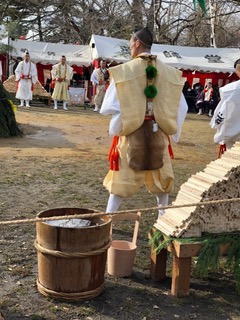
The afternoon is filled with the element of fire, demanding purification and strength of will. This raging intensity is complemented by water, creating a smoke-filled atmosphere that is rhythmically soothed by the ceaseless droning chants of the Yamabushi.

The Yamabushi form a circle around a large pile of green pine branches. They chant and blow conch shell horns that moan across the ritual field.

Before long the fire becomes a raging blaze of madness, shooting flames to the farthest edges of the ritualistic circle. At that point, two Yamabushi grab buckets of water and hurl it at the blaze, frantically repeating the process again and again. Smoke billows everywhere, as onlookers hold their hands in prayer, receiving the sacred energy of the barely controlled flames.

From there, the Yamabushi take wooden sticks with visitors’ prayers and throw them into the fire. As they burn, the hopes and wishes of the devotees ascend upward, where they, hopefully, will be heard and answered.
The fire is raked, salt is thrown into it, and gradually a taming emerges.
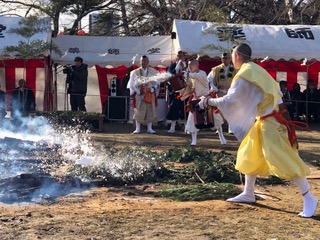
The Yamabushi begin the spiritual challenge, followed by visitors who wish to participate. People come locally and from neighboring prefectures. Everyone fully trusts the process.
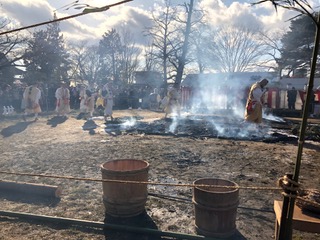
Just then, my foot hit one lone piece of coal that was still brightly burning. The pain shot through me, but I dared not stop. I kept up my even pace, got to the end, walked through several trays of water, over salt and pine branches, finally to a shelter to dry my feet and put on my shoes. I never gave any indication of my burn. It was mine alone. Happily, no one else seemed to have had that sort of mishap. Later at home, I put ice on it and the next day it was fine.
Even now, several days after that experience, I can feel the profound effect it has had, and is still having on me. It is hard to verbalize, but deep within I know there is a change. And for that I am grateful.
Love,
Anne

The Yamabushi form a circle around a large pile of green pine branches. They chant and blow conch shell horns that moan across the ritual field.

They make highly stylized devotional gestures until finally two of them move toward the altar in order to light huge torches with which to ignite the central pyre.


Before long the fire becomes a raging blaze of madness, shooting flames to the farthest edges of the ritualistic circle. At that point, two Yamabushi grab buckets of water and hurl it at the blaze, frantically repeating the process again and again. Smoke billows everywhere, as onlookers hold their hands in prayer, receiving the sacred energy of the barely controlled flames.

From there, the Yamabushi take wooden sticks with visitors’ prayers and throw them into the fire. As they burn, the hopes and wishes of the devotees ascend upward, where they, hopefully, will be heard and answered.
The fire is raked, salt is thrown into it, and gradually a taming emerges.

At that point, one Yamabushi goes to a large fire-filled metal bucket emitting a wall of smoke that seems to consume him. He takes a pine branch and thrusts it into water, which he flings around him. All the while, the chanting continues, maintaining a rhythm that is goes to the very core of life itself.
Finally, the ashes and cinders, still very hot, are subdued enough for the most poignant part of the ritual: fire walking. In a very Japanese way, this extreme is balanced with protective elements. Pine branches form a pathway and a mound of salt is the doorway to step on before entering the arena of fire.
The Yamabushi begin the spiritual challenge, followed by visitors who wish to participate. People come locally and from neighboring prefectures. Everyone fully trusts the process.

We each brought our own mental, emotional and spiritual attitude. So, naturally, the experience differed for each person. For me, a deep silence and calmness seemed to rise up from the very center of my being. Yet, as I moved over the burning embers, I felt a profound sense of aloneness, as if everything nonessential was being stripped away. I wanted to cry, not from sadness, but from a deep surrender. I knew that moment was a culmination of my entire life.
Just then, my foot hit one lone piece of coal that was still brightly burning. The pain shot through me, but I dared not stop. I kept up my even pace, got to the end, walked through several trays of water, over salt and pine branches, finally to a shelter to dry my feet and put on my shoes. I never gave any indication of my burn. It was mine alone. Happily, no one else seemed to have had that sort of mishap. Later at home, I put ice on it and the next day it was fine.
Even now, several days after that experience, I can feel the profound effect it has had, and is still having on me. It is hard to verbalize, but deep within I know there is a change. And for that I am grateful.
Love,
Anne
Ainu and Firewalking
- At February 11, 2020
- By admin
- In Annes Letters
 0
0
Dear Family and Friends,
In Sendai at the moment there is an exhibition of Ainu artifacts. Most items in the show are textiles, but there are also useful containers carved from wood. Each piece is handcrafted from purely natural materials. Despite the intricacy of design and precision of craftmanship, these artistic wonders were mainly for daily use. Yet, for the Ainu, everyday life and the sacred are one.
In Sendai at the moment there is an exhibition of Ainu artifacts. Most items in the show are textiles, but there are also useful containers carved from wood. Each piece is handcrafted from purely natural materials. Despite the intricacy of design and precision of craftmanship, these artistic wonders were mainly for daily use. Yet, for the Ainu, everyday life and the sacred are one.
These days I am filled with questioning and often wonder how Cosmic patterns are manifesting in the world today, despite the upheavals happening almost everywhere. The Ainu show seemed to give me some answers. Each room was filled with magnificent specimens of fine workmanship. Each stitch on their appliqued outfits reflected a tender, precise exactness that honored not only the craftsperson, but also the ones who wore them, and even more so, the natural world that offered itself for human use. As I sensed the energy emitted from each piece, I could feel the essence of the earth, the plants that provided the fibers and wood, and the oneness of humanity with the natural world. There was no separation. There was a continuous flow of life between the two.

What struck me on a more overt level, though, were the designs themselves. They consisted of interlocking geometric shapes of swirls and curves that formed cohesive patterns that perfectly united the background and the applique. Each piece was breathtakingly magnificent. But they did not shout. Rather, they spoke with the quiet dignity of their majestic presence. It was as if the owners both knew and yet did not realize the immensity of their own power and that of their robes.

And sure enough, one room, with one jacket after another gracing the walls, felt like a cathedral. But rather than light-filled stained glass, these were emblems of earth worship and deep reverence and humility before a wiser Ordering Power.

I mulled over the idea that these harmonious, unifying patterns might somehow be the Ainu’s way of manifesting Cosmic energies as they felt and understood them. Seeing their fine work, I felt reassured that even today the world is held together safely and strongly, that there are certain archetypal energies that are universal and eternal. The world felt more unified and stable.
Then I thought about the Japanese traditional love of rituals. Shinto shrines and Buddhist temples perform them throughout the year, month by month, week by week, sometimes day by day. They, too, seem like humanity’s way of reflecting a sacred harmony that serves to hold earth in the arms of heaven.
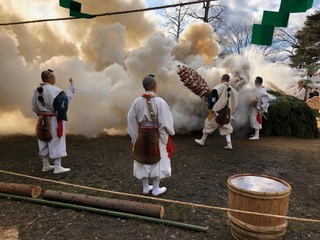
I went to yet another fire ritual this month. This time one that entailed smoke and drums, rhythmic chanting and the moaning of conch shell horns. There was fire walking. Not only by the priests, but by any layperson who wanted to brave the dangers of walking on burning ash and coal. I decided to try. This year I want to push myself beyond what is comfortable and easy, even as I remain acutely aware and respectful of Cosmic laws. I feel time ticking, my age increasing. And so, I want to stretch in ways that evoke both challenge and trust. And in so doing, in my own small life, I want to somehow manifest Cosmic patterns that fit together intricately and harmoniously, both to express cohesiveness, as Ainu craftwork does, and yet to push me into the courage of unchartered territories, as fire walking surely did.
Love,
Anne
Circles and Healing
- At February 03, 2020
- By admin
- In Annes Letters
 0
0
Dear Family and Friends,
The other day I listened to a TEDTalk given by a Turkish writer. Among many things, she mentioned her grandmother. Even though the younger generations of the family had adopted Western ways, the grandmother had remained very traditional. She was also well known in the neighborhood as a healer. People would come to her with skin problems: moles, warts, rough areas, and scars. She would draw a circle around each problem area, take an apple, and pierce it with a needle the number of times there were places to be healed: five warts, five times, for example. About a week later each and every one of her patients would return, healed, grateful, singing her praises. She was 100% successful.
The author, steeped in Western logic, asked her grandmother the secret of her healing talents. “It is the power of the circle,” she would say. “You focus inward, clearly visualize a perfect globe around the aberration, and everything within it gets cut off from life, and soon it dies.”
Several months ago I sprained an ankle, and just when it was starting to heal, I sprained it again. Doing whatever I can to get back to normal, I have been regularly going for massage and acupuncture treatments. Several sessions ago the masseur asked if I wanted to try a burning technique. He explained that it would hurt, but would force the Chi energy to intensely come to the damaged area. That would speed the healing. I decided to give it a try.
He took an incense stick, lit it, placed it on my ankle, and broke off the teeny burning tip. The pain was searing. Even though it was confined to a very small area for a very short time, my entire body reacted. I screamed, stiffened, writhed in agony, but let him perform this torture the required five times.

During the second session a week later, I asked him if I, his sole foreign client, were the only one reacting so violently. “No, there is one other woman who is even noisier than you,” he replied. “How do the others do it?” I asked. “They use the Japanese mind.” “The Japanese mind?”
“You use your mental powers to make a circle around the pain. That way you can contain it. You also breathe slowly and deeply, while visualizing your body as being very calm.”
I tried it. It worked. I still felt the pain, but I also sensed the rest of my body relaxing and working with the process. I realized my mental attitude was allowing the Chi to flow more smoothly to the problem area. At the end of the session, I could walk without pain. A day later, my ankle remained weak, but pain-free.
Yesterday, too, was Setsubun, the change of seasons in the old calendar. Traditionally on that day, people throw beans to keep Oni demons away. This makes a circle of protection around their homes, allowing everyone inside to be safe. As the Oni retreat, so does the harshness of winter, ushering in the promise of spring.

Mental powers focused on healing, circles, the promise of hope. A traditional belief system that maybe we need now more than ever.
Love,
Anne
The other day I listened to a TEDTalk given by a Turkish writer. Among many things, she mentioned her grandmother. Even though the younger generations of the family had adopted Western ways, the grandmother had remained very traditional. She was also well known in the neighborhood as a healer. People would come to her with skin problems: moles, warts, rough areas, and scars. She would draw a circle around each problem area, take an apple, and pierce it with a needle the number of times there were places to be healed: five warts, five times, for example. About a week later each and every one of her patients would return, healed, grateful, singing her praises. She was 100% successful.
The author, steeped in Western logic, asked her grandmother the secret of her healing talents. “It is the power of the circle,” she would say. “You focus inward, clearly visualize a perfect globe around the aberration, and everything within it gets cut off from life, and soon it dies.”
Several months ago I sprained an ankle, and just when it was starting to heal, I sprained it again. Doing whatever I can to get back to normal, I have been regularly going for massage and acupuncture treatments. Several sessions ago the masseur asked if I wanted to try a burning technique. He explained that it would hurt, but would force the Chi energy to intensely come to the damaged area. That would speed the healing. I decided to give it a try.
He took an incense stick, lit it, placed it on my ankle, and broke off the teeny burning tip. The pain was searing. Even though it was confined to a very small area for a very short time, my entire body reacted. I screamed, stiffened, writhed in agony, but let him perform this torture the required five times.

During the second session a week later, I asked him if I, his sole foreign client, were the only one reacting so violently. “No, there is one other woman who is even noisier than you,” he replied. “How do the others do it?” I asked. “They use the Japanese mind.” “The Japanese mind?”
“You use your mental powers to make a circle around the pain. That way you can contain it. You also breathe slowly and deeply, while visualizing your body as being very calm.”
I tried it. It worked. I still felt the pain, but I also sensed the rest of my body relaxing and working with the process. I realized my mental attitude was allowing the Chi to flow more smoothly to the problem area. At the end of the session, I could walk without pain. A day later, my ankle remained weak, but pain-free.
Yesterday, too, was Setsubun, the change of seasons in the old calendar. Traditionally on that day, people throw beans to keep Oni demons away. This makes a circle of protection around their homes, allowing everyone inside to be safe. As the Oni retreat, so does the harshness of winter, ushering in the promise of spring.

Mental powers focused on healing, circles, the promise of hope. A traditional belief system that maybe we need now more than ever.
Love,
Anne
Rituals and Stability
- At January 14, 2020
- By admin
- In Annes Letters
 0
0
Dear Family and Friends,
Why do rituals both disturb and reassure? Are they designed to awaken parts of ourselves that we might not want to see, yet at the same time offer a stabilizing familiarity? Probably both, maybe neither.
The Japanese are renowned for their love of order and predictability. Even when the world seems to be disintegrating before our very eyes, within our very hearts, the Japanese have ways that seem to hold things together. There is the exact timing of the bullet trains, for example, which run to the second. Or the precise dates of natural phenomena, such as the progressive arrival of cherry blossoms from south to north.
Listening to the news, I am often pulled apart by the dangerous, far-reaching choices of only a few world leaders or the devastating consequences of climate change. I wonder where we are headed. And more importantly, I ponder what can unify us, both as a group and as individuals worldwide.

January 14 is Dontosai, a New Year’s ritual here in Japan. It is based on fire, on burning the old to purify the new. It demands challenges of fending off the cold, of walking through the city scantily clad, shivering, carrying lanterns, ringing bells, winding one’s way to shrines for warmth and blessing.
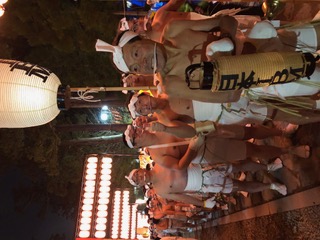
It is important that company members join this ritual, this test of strength, this demand to put group cohesiveness over individual comfort and desire. And people come, year after year. Groups join to be tested and purified. Individuals come to pray, to hope for a year of good fortune and of luck.

It is a happy ritual. It challenges, yes, but also reassures. It draws our hearts and minds to an intangible center that is cohesive and eternal. This ritual reminds us that no matter what is going on in the world, there is a place, a condition where there is peace and trust, stillness and an infinite sense of belonging. What more could we ask in this age of upheaval and ever increasing distrust?
Love,
Anne
Why do rituals both disturb and reassure? Are they designed to awaken parts of ourselves that we might not want to see, yet at the same time offer a stabilizing familiarity? Probably both, maybe neither.
The Japanese are renowned for their love of order and predictability. Even when the world seems to be disintegrating before our very eyes, within our very hearts, the Japanese have ways that seem to hold things together. There is the exact timing of the bullet trains, for example, which run to the second. Or the precise dates of natural phenomena, such as the progressive arrival of cherry blossoms from south to north.
Listening to the news, I am often pulled apart by the dangerous, far-reaching choices of only a few world leaders or the devastating consequences of climate change. I wonder where we are headed. And more importantly, I ponder what can unify us, both as a group and as individuals worldwide.

January 14 is Dontosai, a New Year’s ritual here in Japan. It is based on fire, on burning the old to purify the new. It demands challenges of fending off the cold, of walking through the city scantily clad, shivering, carrying lanterns, ringing bells, winding one’s way to shrines for warmth and blessing.

It is important that company members join this ritual, this test of strength, this demand to put group cohesiveness over individual comfort and desire. And people come, year after year. Groups join to be tested and purified. Individuals come to pray, to hope for a year of good fortune and of luck.

It is a happy ritual. It challenges, yes, but also reassures. It draws our hearts and minds to an intangible center that is cohesive and eternal. This ritual reminds us that no matter what is going on in the world, there is a place, a condition where there is peace and trust, stillness and an infinite sense of belonging. What more could we ask in this age of upheaval and ever increasing distrust?
Love,
Anne



